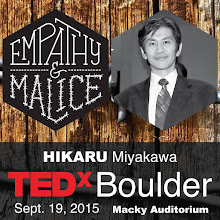The drawing of a left hand of Thomas
I've recently come across the image of what appears to be the drawing of a left hand done by Leonardo da Vinci or by his follower. I did not need to ask myself the questions such as : "Who's hand is this?" or "For what purpose did Leonardo (or his follower) draw this hand?" It was obvious to me that this hand 'belonged' to Thomas in "The Last Supper" by Leonardo.
Although the restoration work of "The Last Supper" was criticized by some of the art critics and the art historians, I applaud the painstaking 22 year effort of Dr. Pinin Brambilla Barcilon. One of the mysteries or questions I have had had been cleared. It has to do with the left hand of Thomas. When I was preparing for the mural of quasi-copy of Leonardo's "The Last Supper," I have come across with some literature mentioning of the presence of the left hand of Thomas. Certainly, I have seen the left hand of Thomas painted by the early copyists of the mural, but I was not able to make out the shape of the hand by examining the pre-restoration photos of the original mural. Some restorers in the past seem to have painted the bread in the place of Thomas' left hand. In 1995-1996, when I was painting the copy, I've had to use the copies of the mural done by the followers to figure out where to place the left hand, for the restoration of the original mural was still not complete, and the photos were not yet available. (The image is from my mural. You can see the left hands of James the Greater and Thomas.)
Thanks to the restoration by Dr. Brambilla, I can see the left hand of Thomas with its fingers somewhat bent.
If you go to the following site, you can see the drawing in question. If you pay attention to the thumb, you can see that it appears to be "cut off". It is because the person is holding or holding onto the table. If you remember the gesture of Thomas, while he is pointing upwards with his right hand, the torso is leaning towards Jesus; therefore, he needs to hold onto the table in order not to fall forward. Also, from the evidence that the horizontal table line where the thumb is cut off is slightly raised towards the hand, and the fingers appears to be bent, one can imagine that it is due to the force of the left hand grabbing onto the table and pulling the table cross. The thumb is grabbing the side of the table, so it is hidden from the viewer.
http://www.art.com/products/p13304152-sa-i2453024/leonardo-da-vinci-study-of-a-left-hand.htm?ui=5CE751E79C224472B883B0C14D5355F5
 | ||||
| The two hands in the Last Supper by HIkaru |
I've recently come across the image of what appears to be the drawing of a left hand done by Leonardo da Vinci or by his follower. I did not need to ask myself the questions such as : "Who's hand is this?" or "For what purpose did Leonardo (or his follower) draw this hand?" It was obvious to me that this hand 'belonged' to Thomas in "The Last Supper" by Leonardo.
Although the restoration work of "The Last Supper" was criticized by some of the art critics and the art historians, I applaud the painstaking 22 year effort of Dr. Pinin Brambilla Barcilon. One of the mysteries or questions I have had had been cleared. It has to do with the left hand of Thomas. When I was preparing for the mural of quasi-copy of Leonardo's "The Last Supper," I have come across with some literature mentioning of the presence of the left hand of Thomas. Certainly, I have seen the left hand of Thomas painted by the early copyists of the mural, but I was not able to make out the shape of the hand by examining the pre-restoration photos of the original mural. Some restorers in the past seem to have painted the bread in the place of Thomas' left hand. In 1995-1996, when I was painting the copy, I've had to use the copies of the mural done by the followers to figure out where to place the left hand, for the restoration of the original mural was still not complete, and the photos were not yet available. (The image is from my mural. You can see the left hands of James the Greater and Thomas.)
Thanks to the restoration by Dr. Brambilla, I can see the left hand of Thomas with its fingers somewhat bent.
If you go to the following site, you can see the drawing in question. If you pay attention to the thumb, you can see that it appears to be "cut off". It is because the person is holding or holding onto the table. If you remember the gesture of Thomas, while he is pointing upwards with his right hand, the torso is leaning towards Jesus; therefore, he needs to hold onto the table in order not to fall forward. Also, from the evidence that the horizontal table line where the thumb is cut off is slightly raised towards the hand, and the fingers appears to be bent, one can imagine that it is due to the force of the left hand grabbing onto the table and pulling the table cross. The thumb is grabbing the side of the table, so it is hidden from the viewer.
http://www.art.com/products/p13304152-sa-i2453024/leonardo-da-vinci-study-of-a-left-hand.htm?ui=5CE751E79C224472B883B0C14D5355F5
http://www.art.com/asp/View_HighZoomResPop.asp?apn=13304152&imgloc=23-2362-Z00DJG2Y.jpg&imgwidth=776&imgheight=773






